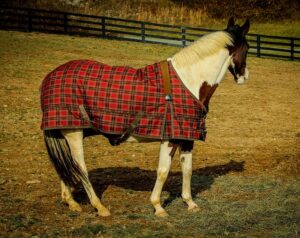 When winter temps plunge, you layer on extra clothing to keep your body warm when you’ll be outside for an extended period of time. Should you do the same for your horse? You know that you’ve seen others blanket select horses though, so what factors must be considered before blanketing your horses? It’s best to weigh the pros against the cons before this becomes a part of your daily care routine.
When winter temps plunge, you layer on extra clothing to keep your body warm when you’ll be outside for an extended period of time. Should you do the same for your horse? You know that you’ve seen others blanket select horses though, so what factors must be considered before blanketing your horses? It’s best to weigh the pros against the cons before this becomes a part of your daily care routine.
Watch the Forecast
A horse’s long hair coat and fat layer naturally defend the horse against cold winter temperatures; many breeds can even endure extended exposure to temperatures between 20-30°F. If your horse will be prohibited from entering its shelter during temps in this range, will its natural system be able to keep up with the elements? Keep in mind the weather forecast; rain and high winds may make it feel much colder than what the thermometer reads. Your horse’s natural ability to keep warm may need additional help. Definitely check with your vet about this if your horse has been ill or is very old or very young. Your vet can help you determine if your horse’s body condition score indicates a need for a blanket. Many horses will be just fine without a blanket if their hay intake is increased. As the horse digests its food, fermentation in the gut generates more heat that will help keep the animal warm. Also, some breeds naturally withstand low temperatures better than others.
Don’t Sweat It
A blanket can help a horse maintain its body temperature. If waterproof, it can help keep moisture off. Some breeds don’t need this extra protection, but others may. Draft horses, for instance, may not be bothered by poor winter conditions, but clipped show horse may need extra protection. If a horse were to be comfortable naturally in the cold weather, adding a blanket could be harmful. If the horse gets too hot, it could sweat. Sweat trapped beneath the blanket could then cause the horse to become dangerously cold. Water trapped underneath the blanket yields the same result. You don’t want blanketing to create a heat loss.
Learn How to Blanket Properly
Adding a blanket atop your horse isn’t as simple as draping an afghan around your shoulders. It’s a process that takes time, and you will probably need to remove it daily also. Dedicating the time to blanket your horse may be difficult, and this is often the sole reason why some owners don’t blanket their horses. Owners have many reasons though. Some believe that horses that are blanketed often may lose their natural tolerance to the cold.
Know Your Blankets
If you decide to blanket your horse, you’ll find many options of blankets. Both indoor and outdoor varieties are available in different sizes. The type of material creating the outer layer will differ. Those for use outdoors may or may not be waterproof. Both indoor and outdoor blankets are filled with a variety of materials promising varying degrees of protection from the cold. Find out how to properly care for the blanket you choose. You’ll always want it clean and dry before placing it on your horse, so be sure to follow the instructions for care as well as fitting it to the horse. You don’t want any straps rubbing sores into its skin or tangling around its legs, which could cause an accident.
In Conclusion
Horses have great natural defenses against cold temperatures, but there are situations in which a blanket may be helpful to a horse. Carefully consider if adding a blanket is necessary for your horse’s wellbeing. Consult your veterinarian to see what is recommended for your breed’s current age and health condition.
